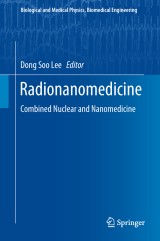Details

Radionanomedicine
Combined Nuclear and NanomedicineBiological and Medical Physics, Biomedical Engineering
|
96,29 € |
|
| Verlag: | Springer |
| Format: | |
| Veröffentl.: | 25.05.2018 |
| ISBN/EAN: | 9783319677200 |
| Sprache: | englisch |
Dieses eBook enthält ein Wasserzeichen.
Beschreibungen
<p>This book describes radionanomedicine as an integrated medicine using exogenous and endogenous This book describes radionanomedicine as an integrated approach that uses exogenous and endogenous nanomaterials for in vivo and human applications. It comprehensively explains radionanomedicine comprising nuclear and nanomedicine, demonstrating that it is more than radionanodrugs and that radionanomedicine also takes advantage of nuclear medicine using trace technology, in which miniscule amounts of materials and tracer kinetic elucidate in vivo biodistribution.</p> <p></p>It also discusses exogenous nanomaterials such as inorganic silica, iron oxide, upconversion nanoparticles and quantum dots or organic liposomes labelled with radioisotopes, and radionanomaterials used for targeted delivery and imaging for theranostic purposes. Further, it examines endogenous nanomaterials i.e. extracellular vesicles labelled with radioisotopes, known as radiolabelled extracellular vesicles, as well aspositron emission tomography (PET) and single photon emission computed tomography (SPECT), which elucidate the biodistribution and potential for therapeutic success.<p></p><p></p><p></p>
<p>Introduction of Radionanomedicine.- Exogenous Radionanomedicine.- Endogenous Radionanomedicine.- Surface Modification and Radiolabeling.- Targeted Delivery with Click Chemistry.- In-vivo Biodistribution Using PET and SPECT.- Factors and Results Affecting Biodistribution.- Immune Responses to Nanomaterials.- Molecular Imaging.- Theranostic Utility.</p>
<p>Dong Soo Lee, M.D.Ph.D. is a nuclear medicine physician and nanomedicine expert who is a professor of nuclear medicine in Seoul National University (SNU) and SNU hospital since 1990. He is also a professor and chairman of the department of molecular medicine and biopharmaceutical sciences of SNU. He has implemented the concept of ‘Radionanomedicine’ which takes the advantage of tracer principle of nuclear medicine using trace amount of materials and enabling tracer kinetic studies for nanomaterial use in vivo. He is currently the director of BioMAX/N-Bio Institute of SNU to practice and promote bio convergence approaches of innovative developments of fundamental sciences/engineering to clinical application. He is past-president of Korean Society for Nanomedicine and past-president of Korean Society of Nuclear Medicine as well as past-president of Korean Society of Human Brain Mapping. As a nuclear medicine physician, he specialized in nuclear cardiology and neurology as well a</p>smolecular imaging (in vitro and preclinical) and radionanomedicine. He is a graduate of 1982 from SNU, Korea as an MD and received PhD from the same university SNU in 1990 and served as faculty of nuclear medicine in SNU since then. He has authored more than 300 articles in peer-reviewed SCI journals, and edited several books including the ‘Atlas of PET/MRI, PET/CT and SPECT/CT’ in 2016 by Springer-Nature. He is the Editor-in-Chief of ‘Nuclear Medicine Molecular Imaging’ since 2015 and has served in the Editorial Board of Journal of Nuclear Medicine, European Journal of Nuclear Medicine and Molecular Imaging, Journal of Nuclear Cardiology and European Journal of Nanomedicine. He is a Fellow of American College of Cardiology and member of Korean Academy of Science and Technology since 2006, and member of National Academy of Medicine of Korea since 2015.<p></p><p></p><p></p><p></p>
<p>This book describes radionanomedicine as an integrated medicine using exogenous and endogenous This book describes radionanomedicine as an integrated approach that uses exogenous and endogenous nanomaterials for in vivo and human applications. It comprehensively explains radionanomedicine comprising nuclear and nanomedicine, demonstrating that it is more than radionanodrugs and that radionanomedicine also takes advantage of nuclear medicine using trace technology, in which miniscule amounts of materials and tracer kinetic elucidate in vivo biodistribution.</p> <p></p>It also discusses exogenous nanomaterials such as inorganic silica, iron oxide, upconversion nanoparticles and quantum dots or organic liposomes labelled with radioisotopes, and radionanomaterials used for targeted delivery and imaging for theranostic purposes. Further, it examines endogenous nanomaterials i.e. extracellular vesicles labelled with radioisotopes, known as radiolabelled extracellular vesicles, as well aspositron emission tomography (PET) and single photon emission computed tomography (SPECT), which elucidate the biodistribution and potential for therapeutic success.<p></p><p></p><p></p>
Features radionanomedicine as a novel opportunity for nuclear medicine Covers not just radionanomaterials and radionanodrugs but also radionanomedicine enabling clinical translation Discusses tracing endogenous and exogenous nanomaterials with tracer kinetics for in vivo and human applications
<p>Features radionanomedicine as a novel opportunity for nuclear medicine</p><p>Covers not just radionanomaterials and radionanodrugs but also radionanomedicine enabling clinical translation</p><p> </p><p>Discusses tracing endogenous and exogenous nanomaterials with tracer kinetics for in vivo and human applications</p>
Diese Produkte könnten Sie auch interessieren:

Alzheimer's Disease: Cellular and Molecular Aspects of Amyloid beta

von: J. Robin Harris, Falk Fahrenholz

213,99 €















